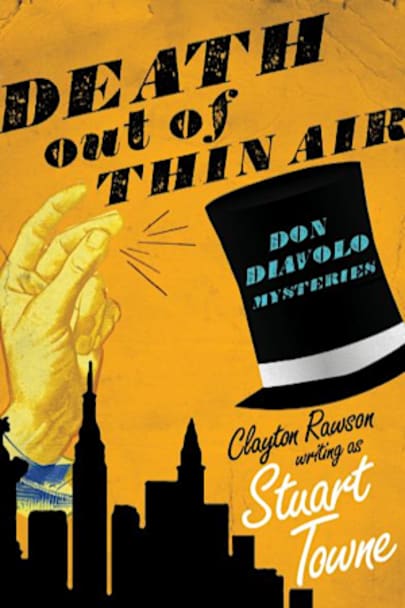Two tall tales of mystery, the occult, and death-defying escapes The women of London have taken to wearing thin black bands around their necks. Is it a fashion accessory–or a stylish way of hiding bite marks? A string of strange deaths has struck the town, and witnesses claim to have seen a vampire bat fleeing the scene. The London police can rest easy, for the vampire has left for New York. He … vampire has left for New York. He makes his first appearance in a Broadway dressing room, piercing the neck of a woman who had come to speak to Don Diavolo, magician and escape artist. The police suspect Diavolo of killing her, forcing him to catch the vampire or face the chair.
more



Author, editor, and amateur magician Clayton Rawson is best remembered as the creator of The Great Merlini, a magician who had a knack for solving seemingly impossible crimes. Under the pseudonym Stuart Towne, Rawson created Don Diavolo, a magician/escape artist/ventriloquist who was billed as “the Scarlet Wizard” for his bright red on-stage evening clothes. Diavolo appeared in four short novel-length tales which appeared in *Red Star Mystery*, a short-lived pulp fiction magazine from 1940, and tended—like Merlini (who’s alluded to in one of the novels)—to get involved in a variety of impossible crime situations.
Diavolo has his own cast of supporting players. These include reporter/columnist for the New York Press J. Haywood (“Woody”) Haines, Jr.; Karl Hartz, the engineer of Don’s stage illusions; Patricia Collins and her twin sister Mickey, Don’s on-stage assistants; the gambler of many aliases most often referred to as the Horseshoe Kid; and the Oxford-educated Chan Chandar Manchu, “Don’s dresser, chef, and general handyman.” Sure that only an illusionist of Diavolo’s caliber could pull them off, Homicide Squad’s Inspector Church regularly hopes to nail the magician for murders he cannot solve himself, despite Don’s ability to prove his innocence by explaining the *who* and *how* of the crimes.
DEATH OUT OF THIN AIR opens with “Ghost of the Undead,” which deals with a murderous cloaked figure whose “face, if it could be called that, was black, and its features were unutterably grotesque and hideous. White pointed teeth gleamed between the bestial lips. The Thing had the face of a bat!”
What ensue are impossible murders and disappearances, impossible thefts of thirty thousand dollars in negotiable securities and half a million in diamonds, and the deadly appearances of the vampiric ghost of Gilles de Rais.
In the eponymous “Death Out of Thin Air,” Sergeant Lester Healy, working undercover, has witnessed the impossible: the vanishing of the lethal entity who came to be known as The Invisible Man: “Healy, you see, had under the bright lights, just watched a man vanish into thin air. He had seen him fade slowly and completely into nothing at all…He had been faced with clearly unmistakable evidence that the man who disappeared was still there under those bright lights—still there but quite invisible.”
Shortly after reporting back to Centre Street Headquarters, Healy is murdered by an invisible killer: someone who is brazen enough to kill one of their own and then challenge the police department to prevent a theft he intends to commit under their very noses. Don Diavolo becomes involved when multi-millionaire financier J.D. Belmont engages him to protect his prized possession, a diamond necklace that belonged to Marie Antoinette. When the invisible man succeeds in stealing it despite elaborate precautions, Diavolo determines to recover it—putting his own life at risk in the process—unmask the killer, and figure out how he effected his crimes and the invisibility.
The Don Diavolo mysteries, are fast-paced short novels which combine cerebral conundrums with the kind of fast-paced physical action (and occasional hokeyness) the pulps were known for.
There are (fortunately *only*) a few instances of offensive racial epithets readers must put into the context of the era in which these short novels were written. As far as I can determine, physical editions of these tales are no longer available. I read them in the electronic editions from Mysterious Press/Open Road Integrated Media, which companies need to hire a competent proofreader. The novels contain their share of missing or incorrect punctuations, as well as occasional misspellings.
With those caveats noted, I can and do recommend these as good entertainment.
© 2017 Barry Ergang